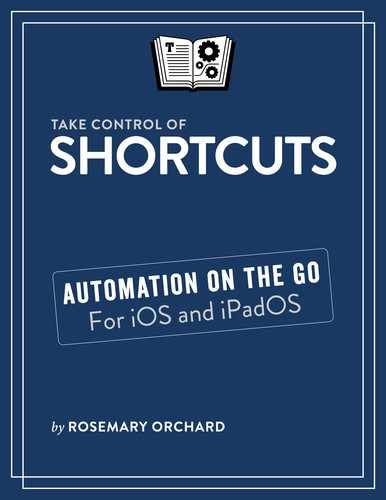Explore The User Interface
Before we start building shortcuts, let’s explore the user interface. First, find the Shortcuts app on your iPhone or iPad and tap its icon. Then we can explore the various areas of the app, and everything in them.
The Shortcuts Tabs
There are three tabs in Shortcuts, which you can switch among by tapping the icons at the bottom of the screen (Figure 1). First is My Shortcuts, which I, and others, sometimes refer to by its former name, the Shortcuts Library. The next tab is Automation, where you can configure shortcuts to run automatically. The final tab is Gallery, where you can download and install prebuilt shortcuts as well as create one-action shortcuts suggested by your apps.

In My Shortcuts is a tile representing each of your shortcuts (once you have added some; until then, you’ll see just a Create Shortcut tile). In the top-left corner of each shortcut is its icon, and at the bottom is the shortcut’s name and the number of actions in it (Figure 2). Tap the icon to run the shortcut, or tap the More ![]() icon in the top-right corner to edit and inspect it. (If you touch and hold the tile, you can rename the shortcut, share it, or open Details—the edit and inspection mode.)
icon in the top-right corner to edit and inspect it. (If you touch and hold the tile, you can rename the shortcut, share it, or open Details—the edit and inspection mode.)

The Shortcuts Editor
The editor interface in Shortcuts (Figure 3) has two main sections, the actions list and the shortcuts editor. On the iPad, the action list displays on the left and the shortcuts editor on the right. On the iPhone, the main view is the editor, and the action list is at the bottom—drag the search area upward to view it.

The More ![]() icon in the shortcuts editor displays a Details view that lets us control where the shortcut appears and more (Figure 4). Here we can rename the shortcut, set its icon, and control whether it should appear in the Today View or the activity view (formerly known as the Share sheet, a term Apple still uses here), and if so, which kinds of files or data it can accept.
icon in the shortcuts editor displays a Details view that lets us control where the shortcut appears and more (Figure 4). Here we can rename the shortcut, set its icon, and control whether it should appear in the Today View or the activity view (formerly known as the Share sheet, a term Apple still uses here), and if so, which kinds of files or data it can accept.

Install and Run Your First Shortcut
Before we wade too far into all the details, let’s have some fun and see an example of what Shortcuts can do:
Open the Gallery in Shortcuts.
Search for
Word of the Day.Tap the Word of the Day shortcut and then tap Add Shortcut (Figure 5).

Figure 5: Install the shortcut from the Gallery. Switch to the My Shortcuts tab, and tap Word of the Day.
When you do this, the shortcut shows you a Quick Look view (a quick preview) of the current word of the day from Merriam Webster’s online dictionary.
